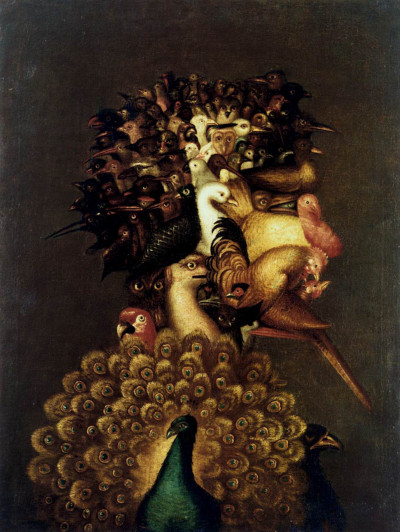Giuseppe Arcimboldo, in the second series, begins creating composite portrait Air. Here Arcimboldo utilises animal-related with each component to craft his figures. Air is a combination of birds, from the ordinary chicken to elaborate parakeet and peacock.
He combined the different animals and came up with a perfect craft for his figures. The animals were placed in an orderly manner to acquire the desired structure. The craft was likely grounded on intricate nature studies. Arcimboldo previously finished the bird of Air, coming up with high accuracy level and attention to detail, not forgetting to enliven the animal in a manner that his studies had started to capture. Air is among Arcimboldo's series, which is a disconcerting portrait in part because of the overwhelming feeling of being observed due to the many eyes staring out and specifically in the head. His craft hair is made by the use of many tight-packed birds in which it's hard to identify any bird because they all compete for prominence.
However, those that are more important can be easily identified. The most vital bird is the peacock which makes up the whole of the body of the portrait with its entire spread and stylish plumage. The peacock was a representation mostly used by the Hapsburg Dynasty, where Arcimboldo patron Maximillian 11 was a participant. The other known bird symbol is the eagle. It can be seen peering out right behind the feathers of the peacock at the bottom on the right side of the painting. Within the four series of the elements, Arcimboldo entails visual symbols and various references to the Maximillian 11 and Hapsburg dynasty stating that composite portraits as a series are meant to emphasize the emperor power and dynasty over the elements.
These crafts were finished after the ascendancy of Maximilian to head of the Holy Emperor in the year 1564, whereas the four seasons were finished before this occasion in the year 1563. Perhaps this more glorifying reference and overt heraldic can be accredited to Maximillian’s raised the status from heir up to the holder of it. As the leader of an empire, the attention to symbolic and overt adoration representations of his home now makes sense, and it's more obvious in their representation. When portrayed with its complement in Air, the four seasons paired with spring, Air assists to embody with the season’s lightness and the peeping of birds can be witnessed as a symbol that spring on its way. The age of the numbers depicted compliments each other where spring is a gorgeous young woman. Air can be recited as a young man with a stylish beard.




